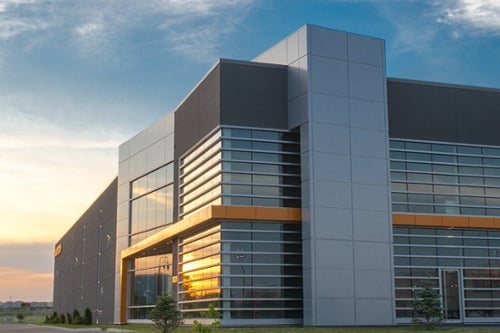This blog allows for all sorts of discussions on topics surrounding pallet racks and the role they play in the warehouse. But rarely do we hear the engineer's point of view on the subject. What are his responsibilities and his contribution as part of a comprehensive rack safety program? Charles Carbonneau is chief engineer at Damotech, and he's our senior advisor on rack safety. Today he tells us about his work and why he thinks we should all care more about the safety of pallet racking systems.
 Charles, thank you for granting us this interview. To begin, can you briefly describe your journey as an engineer?
Charles, thank you for granting us this interview. To begin, can you briefly describe your journey as an engineer?
Starting with my first job, I've contributed to the development and design of software used for the calculation of all kinds of structures; steel, concrete or wood, while respecting North American design codes in consideration of seismic effects.
What led you to specialize in the field of warehouse racking?
In the 2000s, a client approached my team to adapt our software to the specifics of pallet racking calculation. Subsequently, during warehouse visits, I often noticed how neglected these structures were, despite the considerable loads they were bearing. From then on, I became interested in the safety of pallet racks as a focus, and the "training - inspection - certification" adventure began.
Since you've joined Damotech, its team of engineers has grown significantly. What is the role of the engineer who works at Damotech?
Our engineers travel across North America to perform pallet rack inspections in warehouses and distribution centers. They produce compliance reports following local design codes. They keep themselves in good shape by walking row upon row of racks and documenting what they see! Their mandates generally involve taking measurements and pictures of the racks and issues, sometimes calculating the load capacities for operators who have lost track of their configuration drawings (LARCS) or who have made modifications to the systems and want to ensure their conformity. Several of our engineers also provide on-site training on best practices for recognizing hazards and methods of preventing damage to pallet racks.
What are their responsibilities?
The engineer is responsible for producing accurate and precise reports which engage his professional responsibility and which guide the warehouse manager in the procedures to follow to ensure that the pallet racks in his warehouse are (and remain) safe. They must be rigorous and very observant.
Why do you think we should care more about pallet rack safety?
I've visited many warehouses, and each time I make a point of observing how safety is approached there. I once saw a beautiful wall with photos of family members with a sign that said: "This Is Why We Work Safe." This example, for me, says it all. It's frustrating to learn that an accident could have been avoided, which is unfortunately the case with a vast majority of warehouse accidents.
What kind of accidents are we talking about?
We are talking about accidents that can have serious consequences. As a warehouse manager, imagine hearing the crashing sound of a pallet rack, followed by the tremor caused by the domino effect of a collapse. Imagine having to count your employees to determine if a member of your team is confined somewhere. Think of the time and effort required to try to free them from such a mess. Not to mention dealing with the aftermath of such an event.
Of course, there are these extreme cases, but what about a warehouse that is not exposed to such an event?
Warehousing is becoming an increasingly competitive field. Serving customers means storing and delivering orders quickly and systematically at a low cost. To achieve this, it's necessary to optimize storage space and the velocity of the pallets. All the pallet positions must be usable, even profitable. To achieve this, you need a pallet rack safety and maintenance program.
When you talk about a pallet rack safety program, what steps are we talking about?
We're talking about having a plan that will ensure the preservation and proper functioning of your storage systems. Safety in this area involves checking the load capacity of the racks, performing regular inspections of the systems, then identifying and repairing damage, and protecting places at risk of being hit. I see the program as a continuous cycle, not just a one-time inspection.
What does this kind of initiative entail, and who should implement it?
A company and its managers have a responsibility towards their workers; they must provide them with a safe workplace. I wrote a blog post about it. If the company has a health and safety team, they must work together on this. Next, you need to know the condition of your pallet racking, and this involves doing a baseline survey, a complete inspection if you will, of the rack systems. After reading the resulting report, measures are put in place to correct the situation and improve the safety of the pallet racks.
And what is the best approach after the inspection? Where to start?
Each warehouse is unique. Some begin by offering training on pallet racking safety to make their workers aware of the issues surrounding the racks. You can get the opinion of an inspector or engineer on the condition of the pallet racks and their load capacity. I advise customers to proceed with repairs or replacements in the places indicated as a priority immediately after the inspection. Don't wait. Then begin a maintenance and inspection cycle to prevent future damage.
How often should we have our racks inspected?
We recommend an (annual) inspection by an independent third party, followed by regular reviews by well-trained employees. In aisles that are used daily, a weekly or daily check may be necessary. Beyond inspections, a process should be put in place for workers to report issues as soon as they are observed. This article shares examples of when you might want to get your racks inspected.
Are there any OSHA rules on the frequency of inspections?
No, because frequency depends on several factors specific to each warehouse. We are often asked this question. Here are some examples of factors. What types of storage systems are we talking about; conventional pallets, drive-in, push back, pallet flow? What is the nature of the operations, is it storage, is it a place where there is a lot of forklift traffic? What are the loading methods? Are the operators well trained? Are there guarding products in place?
Charles, if we wish to attend one of your training sessions, what should we do?
You can sign up to receive news and communications from us or subscribe to this blog. We will soon announce the upcoming training sessions for the year. To become an engineer at Damotech, visit this page.










